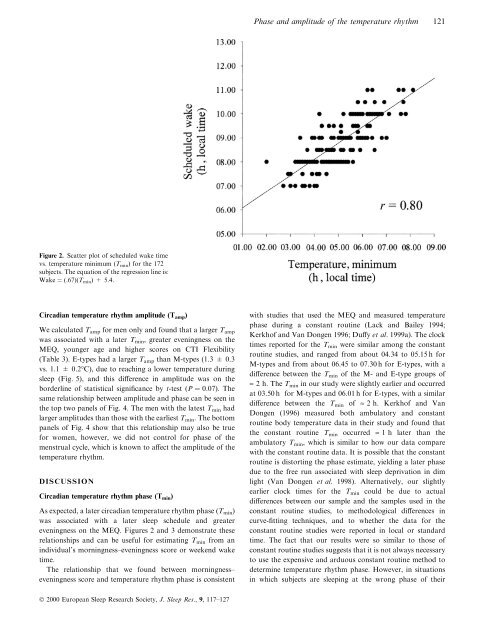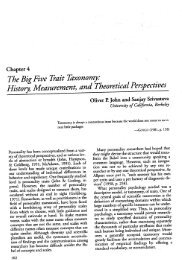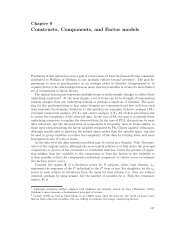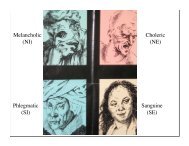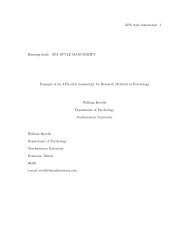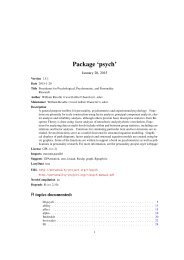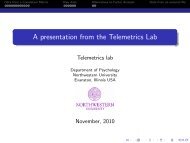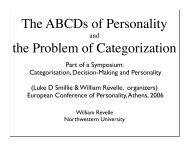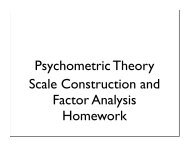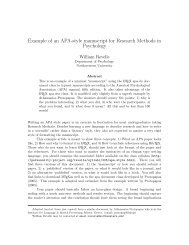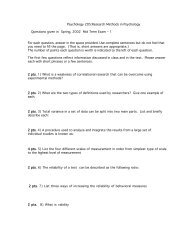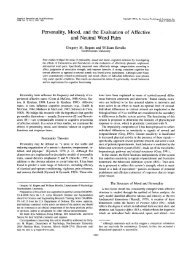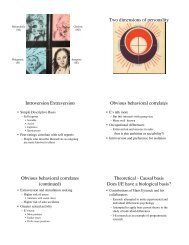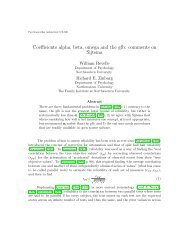Individual differences in the phase and amplitude of the human ...
Individual differences in the phase and amplitude of the human ...
Individual differences in the phase and amplitude of the human ...
Create successful ePaper yourself
Turn your PDF publications into a flip-book with our unique Google optimized e-Paper software.
Phase <strong>and</strong> <strong>amplitude</strong> <strong>of</strong> <strong>the</strong> temperature rhythm 121Figure 2. Scatter plot <strong>of</strong> scheduled wake timevs. temperature m<strong>in</strong>imum (T m<strong>in</strong> ) for <strong>the</strong> 172subjects. The equation <strong>of</strong> <strong>the</strong> regression l<strong>in</strong>e is:Wake ˆ (.67)(T m<strong>in</strong> ) + 5.4.Circadian temperature rhythm <strong>amplitude</strong> (T amp )We calculated T amp for men only <strong>and</strong> found that a larger T ampwas associated with a later T m<strong>in</strong> , greater even<strong>in</strong>gness on <strong>the</strong>MEQ, younger age <strong>and</strong> higher scores on CTI Flexibility(Table 3). E-types had a larger T amp than M-types (1.3 ‹ 0.3vs. 1.1 ‹ 0.2°C), due to reach<strong>in</strong>g a lower temperature dur<strong>in</strong>gsleep (Fig. 5), <strong>and</strong> this di€erence <strong>in</strong> <strong>amplitude</strong> was on <strong>the</strong>borderl<strong>in</strong>e <strong>of</strong> statistical signi®cance by t-test (P ˆ 0.07). Thesame relationship between <strong>amplitude</strong> <strong>and</strong> <strong>phase</strong> can be seen <strong>in</strong><strong>the</strong> top two panels <strong>of</strong> Fig. 4. The men with <strong>the</strong> latest T m<strong>in</strong> hadlarger <strong>amplitude</strong>s than those with <strong>the</strong> earliest T m<strong>in</strong> . The bottompanels <strong>of</strong> Fig. 4 show that this relationship may also be truefor women, however, we did not control for <strong>phase</strong> <strong>of</strong> <strong>the</strong>menstrual cycle, which is known to a€ect <strong>the</strong> <strong>amplitude</strong> <strong>of</strong> <strong>the</strong>temperature rhythm.DISCUSSIONCircadian temperature rhythm <strong>phase</strong> (T m<strong>in</strong> )As expected, a later circadian temperature rhythm <strong>phase</strong> (T m<strong>in</strong> )was associated with a later sleep schedule <strong>and</strong> greatereven<strong>in</strong>gness on <strong>the</strong> MEQ. Figures 2 <strong>and</strong> 3 demonstrate <strong>the</strong>serelationships <strong>and</strong> can be useful for estimat<strong>in</strong>g T m<strong>in</strong> from an<strong>in</strong>dividual's morn<strong>in</strong>gness±even<strong>in</strong>gness score or weekend waketime.The relationship that we found between morn<strong>in</strong>gness±even<strong>in</strong>gness score <strong>and</strong> temperature rhythm <strong>phase</strong> is consistentwith studies that used <strong>the</strong> MEQ <strong>and</strong> measured temperature<strong>phase</strong> dur<strong>in</strong>g a constant rout<strong>in</strong>e (Lack <strong>and</strong> Bailey 1994;Kerkh<strong>of</strong> <strong>and</strong> Van Dongen 1996; Du€y et al. 1999a). The clocktimes reported for <strong>the</strong> T m<strong>in</strong> were similar among <strong>the</strong> constantrout<strong>in</strong>e studies, <strong>and</strong> ranged from about 04.34 to 05.15 h forM-types <strong>and</strong> from about 06.45 to 07.30 h for E-types, with adi€erence between <strong>the</strong> T m<strong>in</strong> <strong>of</strong> <strong>the</strong> M- <strong>and</strong> E-type groups <strong>of</strong>» 2 h. The T m<strong>in</strong> <strong>in</strong> our study were slightly earlier <strong>and</strong> occurredat 03.50 h for M-types <strong>and</strong> 06.01 h for E-types, with a similardi€erence between <strong>the</strong> T m<strong>in</strong> <strong>of</strong> » 2 h. Kerkh<strong>of</strong> <strong>and</strong> VanDongen (1996) measured both ambulatory <strong>and</strong> constantrout<strong>in</strong>e body temperature data <strong>in</strong> <strong>the</strong>ir study <strong>and</strong> found that<strong>the</strong> constant rout<strong>in</strong>e T m<strong>in</strong> occurred » 1 h later than <strong>the</strong>ambulatory T m<strong>in</strong> , which is similar to how our data comparewith <strong>the</strong> constant rout<strong>in</strong>e data. It is possible that <strong>the</strong> constantrout<strong>in</strong>e is distort<strong>in</strong>g <strong>the</strong> <strong>phase</strong> estimate, yield<strong>in</strong>g a later <strong>phase</strong>due to <strong>the</strong> free run associated with sleep deprivation <strong>in</strong> dimlight (Van Dongen et al. 1998). Alternatively, our slightlyearlier clock times for <strong>the</strong> T m<strong>in</strong> could be due to actualdi€erences between our sample <strong>and</strong> <strong>the</strong> samples used <strong>in</strong> <strong>the</strong>constant rout<strong>in</strong>e studies, to methodological di€erences <strong>in</strong>curve-®tt<strong>in</strong>g techniques, <strong>and</strong> to whe<strong>the</strong>r <strong>the</strong> data for <strong>the</strong>constant rout<strong>in</strong>e studies were reported <strong>in</strong> local or st<strong>and</strong>ardtime. The fact that our results were so similar to those <strong>of</strong>constant rout<strong>in</strong>e studies suggests that it is not always necessaryto use <strong>the</strong> expensive <strong>and</strong> arduous constant rout<strong>in</strong>e method todeterm<strong>in</strong>e temperature rhythm <strong>phase</strong>. However, <strong>in</strong> situations<strong>in</strong> which subjects are sleep<strong>in</strong>g at <strong>the</strong> wrong <strong>phase</strong> <strong>of</strong> <strong>the</strong>irÓ 2000 European Sleep Research Society, J. Sleep Res., 9, 117±127


